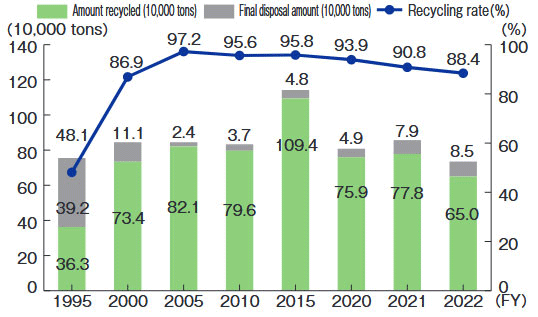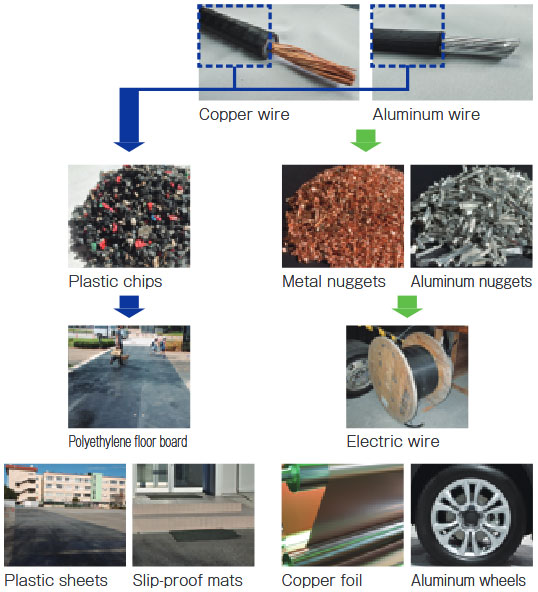Initiatives for Realizing a Circular Economy
Along with our 3R efforts, which call for reducing waste as well as reusing and recycling materials, we will strive to transition to a circular economy in which resources are effectively utilized while continually striving to curtail their input and consumption.
Change in amount of industrial waste generated and rate at which recycled

Status of industrial waste recycling (FY2023)
| Type of industrial waste | Amount generated (t) | Amount recycled (t) | Recycling rate (%) | |
|---|---|---|---|---|
| Coal ash | 560,171 | 484,558 | 86.5% | |
| Other than coal ash | FGD gypsum | 127,401 | 127,389 | 99.9% |
| Debris (scrapped concrete poles, etc.) | 25,887 | 22,437 | 86.7% | |
| Sludge (wastewatertreatment sludge, etc.) | 10,337 | 6,876 | 66.5% | |
| Scrap metal | 4,256 | 3,994 | 93.8% | |
| Heavy and crude oil ash | 2,408 | 2,084 | 86.5% | |
| Waste plastic | 1,409 | 627 | 44.5% | |
| Other (waste oil, glass waste, etc.) | 3,739 | 2,432 | 65.0% | |
| Total | 735,608 | 650,397 | 88.4% HEPCO achieved recycling rate |
|
*Figures in the table include those for HEPCO Group companies.
Plastic recycling, etc.
Plastics are used in many places including power generation equipment, transmission and distribution systems, and buildings.
Power distribution lines, the length of which exceeds the Earth's circumference (approx. 40,000 km), utilize much plastic for wire coatings, insulation covering, and other uses.
HEPCO Group strives to separate plastics used for power distribution, of which 300 tons are discharged annually, according to product type and material. We have recycled 100% of this plastic.
We will work to improve these efforts throughout the entire HEPCO Group by applying good practices and forming alliances throughout the group.
Information Disclosure Pursuant to Plastic Resource Recycling Promotion Act
In accordance with the Act on Promotion, etc. of Recycling Plastic-Related Resources (Plastic Resource Recycling Promotion Act) which took effect in April 2022, we publicly release figures about our emissions performance for industrial waste comprised of plastic products during the previous fiscal year as part of our duty as a waste-generating business.
In FY2023, two companies in the HEPCO Group were categorized as large waste-generating businesses (generating 250 tons or more during the preceding fiscal year). In line with the HEPCO Group FY2024 targets, we will contribute to promoting plastic recycling in Japan.
Status of emissions, recycling, etc. of plastic product industrial and other waste (FY2023 figures)
| Company | Amount emitted (t) | Amount recycled, etc. (t) |
|---|---|---|
| Hokkaido Electric Power | 51 | 40 |
| Hokkaido Electric Power Network | 317 | 252 |
| Hokkai Electrical Construction | 722 | 83 |
*Only the three companies with considerable emissions are list ed.
Targets relating to emission reductions, recycling, etc.
| HEPCO Group FY2024 target (environmental management target) |
Promote the reduction and recycling of waste plastic emissions |
|---|
Recycling of Power Wires
We gathered power lines, which were set to be scrapped, from throughout Hokkaido at a recycling plant in Tomakomai City. The power lines were meticulously separated into the different materials and recycled into plastic chips and metal nuggets, which are able to be processed as resources again.
The plastic chips and metal nuggets are used as raw material. Plastic is made into floor boards and mats, the metal into power wires again as well as aluminum wheels, copper foil, etc.
When materials set to be discarded are recycled, energy is significantly reduced compared to the manufacturing of new material, which leads to reductions in fossil fuel use as well as CO2 emissions.
Examples of recycled power wires
